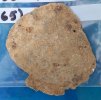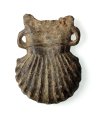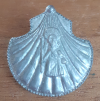Hmm... interesting... myself and partner who was previously a manager in the UK youth hostel association, were able to stop in various hostels free of charge. One of which was Wymering Manor in Southampton, a decaying manor house, with a very long history, and as an aside, was once regarded as one of the most haunted houses in the UK. We stopped there a few times on route to the channel ferry... once entirely on our own, which was not entirely pleasant!
That aside, it was a seriously odd place.
With reference to the o.p, on one visit , plumbers had found a store of pewter tokens under floorboards which were apparently awards given to people who had completed pilgrimages. The doubly interesting thing was, although they were indeed very old, they were very old knock offs, which dishonest individuals could purchase for a sum, presumably to impress others, Iirc, they were around 4" tall, on flattened pewter, with embossed features. Funny old place ..



















